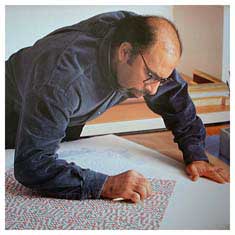

 Born in Alexandria, Egypt, in 1943, Dr. Ahmed Moustafa is an artist and scholar of international
repute and a leading authority on Arabic art and design. Initially trained as a figurative
artist in the neoclassical European tradition, and drawing his inspiration primarily from
Renaissance masters, he subsequently rediscovered his Islamic roots, and his work is now almost
exclusively devoted to abstract compositions inspired by texts from the Holy Qur'an. He has
created an astonishingly rich visual vocabulary through an innovative fusion of his skills as a
painter and as a master scribe in the tradition of Islamic penmanship.
Born in Alexandria, Egypt, in 1943, Dr. Ahmed Moustafa is an artist and scholar of international
repute and a leading authority on Arabic art and design. Initially trained as a figurative
artist in the neoclassical European tradition, and drawing his inspiration primarily from
Renaissance masters, he subsequently rediscovered his Islamic roots, and his work is now almost
exclusively devoted to abstract compositions inspired by texts from the Holy Qur'an. He has
created an astonishingly rich visual vocabulary through an innovative fusion of his skills as a
painter and as a master scribe in the tradition of Islamic penmanship.
Dr. Moustafa has lived and worked in London since 1974 and directs the Fe-Noon Ahmed Moustafa Research Centre for Arab Art and Design, which he established in 1983. He has taught and lectured in many parts of the world, and is currently a visiting professor at the Prince of Wales's Institute of Architecture, London, the University of Westminster, London, and the Faculty of Fine Arts, University of Alexandria, Egypt.
He has recently been appointed to a Fellowship in Islamic Art at the Oxford Centre for Islamic Studies.
Exhibitions of his versatile output, encompassing paintings, tapestries, silk-screen prints, and stained glass, have been held in numerous major locations worldwide.
The range of mediums in which his art has found expression reflects the highly creative and productive relationships he has built up with some of the finest craftsmen and technicians in Europe, notably the weavers of the Pinton family studio in Felletin-Aubusson, France, and the stained glass producers of the Derix Studio in Taunusstein, Germany.
His work is held in many private collections and prestigious institutions, including national museums in Britain and Egypt and other public venues of international importance around the world.
In 1997, in recognition of his international renown in the field of
Islamic art, and his special position as a British Muslim artist based
for so many years in England, Her Majesty Queen Elizabeth II presented
a specially commissioned composition by Ahmed Moustafa entitled Where
The Two Oceans Meet as a gift to the Nation of Pakistan to mark
the occasion of Pakistan's fiftieth anniversary.
This masterpiece of multi-layered Islamic calligraphy, presented by Her Majesty in Islamabad at an exhibition entitled "Traditions of Respect - Britain and Islamic Culture" and sponsored by the British Council, reflects the paramount importance Ahmed Moustafa attaches to building cultural bridges of mutual respect and understanding through the medium of his art.
This same theme of cultural bridge-building is central to the 1998 exhibition of his work in the Pontificia Universitas Gregoriana, sponsored by the Altajir World of Islam Trust, the first exhibition by a Muslim artist in the Vatican and a milestone in the development of Christian-Muslim relations.
Ahmed Moustafa gained a B.A.degree in Fine Arts with Highest National Distinction in 1966 from the University of Alexandria, where he remained as a lecturer in painting and stage design in the Faculty of Fine Arts until 1973.
He won major prizes for his Occidental painting and sculpture at the International Biennales of Alexandria in 1968 and 1974.
In 1974, he was awarded a scholarship to pursue advanced studies in printmaking at the Central School of Art and Design in London, where he obtained his M.A. degree with Distinction in 1978, and where he lectured in Arabic calligraphy from 1980 to 1982, as well as being a tutor-assessor for post-graduate studies in Arabic type design.
In 1989, after eleven years of painstaking research, he was awarded a Ph.D. degree by the Council for National Academic Awards for his work on the Scientific Foundation of Arabic Lettershapes undertaken at the Central School of Art and Design, in collaboration with the British Museum.
This remarkable piece of research, which deserves wider recognition, revealed the exact geometric grid underlying the "proportioned script" developed by the ninth century vizier and scribe Ibn Muqla, whose time-honoured criteria for executing Arabic lettershapes have been followed for over a thousand years.
By extension, Ahmed Moustafa's rediscovery has illuminated the geometric principles underpinning the visual harmony of all Islamic art and architecture.
[the cube] [description] [history] [pictures] [info] [the artist] [other works]